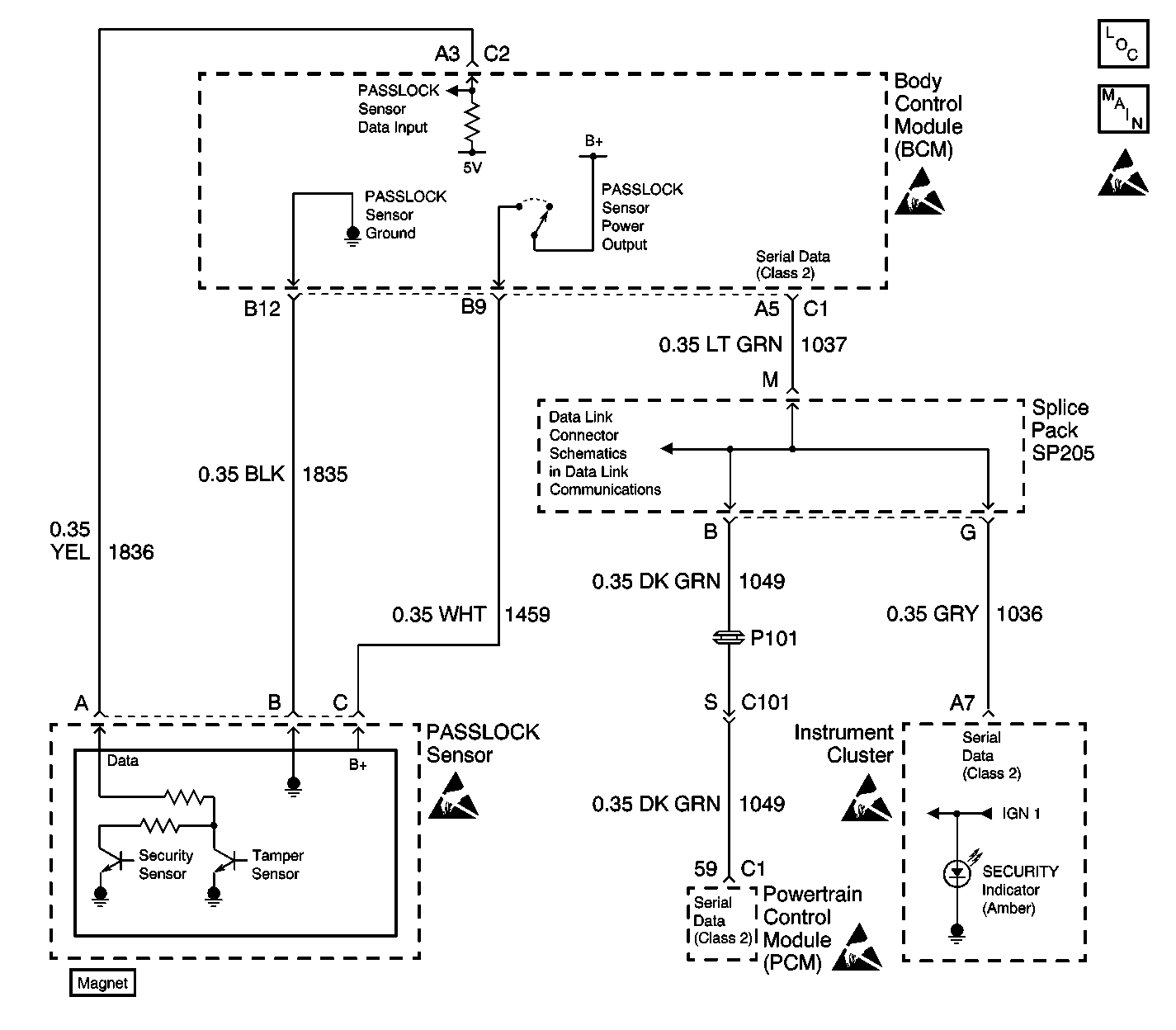
Circuit Description
The Passlock theft deterrent system contains a Passlock sensor that is part of the ignition lock cylinder assembly. The body control module (BCM) provides voltage (B+) to the Passlock sensor through the Passlock sensor power circuit when the ignition switch is in the ACCESSORY, ON, or START position. The BCM also provides a 5-volt reference to the Passlock data circuit. The BCM provides ground to the Passlock sensor through the Passlock sensor ground circuit. The Passlock sensor interfaces with the BCM through the Passlock sensor data circuit.
When you turn the ignition switch to the START position with the proper key, the Passlock sensor applies a unique resistance value to the Passlock Data Circuit which pulls the 5-volt reference down to a unique voltage value, which is measured by the BCM. This voltage signal is unique and varies from vehicle to vehicle. When you attempt to start the engine, the BCM compares a previously stored (learned) voltage value with the circuit voltage value:
| • | When the values match, the BCM sends a fuel enable password via the Class 2 serial data link to the powertrain control module (PCM). The PCM then enables the crank relay, and allows fuel delivery to the engine. |
| • | When the values do not match, the BCM sends a fuel disable password via the Class 2 serial data link to the powertrain control module (PCM). As a result, the PCM disables the crank relay, and does not allow fuel delivery to the engine. |
Conditions for Setting the DTC
While programming a service replacement BCM, the BCM is unable to detect a valid voltage signal on the data circuit of the Passlock sensor, due to other circuit malfunctions, such as an open or a short in the Passlock circuits.
Action Taken When the DTC Sets
| • | The BCM stores DTC B3031 in the BCM memory. |
| • | The BCM enters fail-enable mode. |
| • | The BCM sends a message to the instrument cluster to turn ON the SECURITY indicator. |
| • | The BCM sends a message to the PCM via Class 2 serial data link to enable the crank relay, and to deliver fuel to the engine; this action allows the engine to crank and start. |
Conditions for Clearing the DTC
| • | A current DTC B3031 clears when the BCM detects a valid Passlock sensor data voltage signal on the Passlock sensor data circuit. |
| • | A history DTC clears after 100 consecutive ignition cycles if the condition for the malfunction is no longer present. |
Diagnostic Aids
| • | If an open or a short exists in circuits 1459, 1835, or 1836, the BCM cannot read a valid data voltage signal from the data circuit while the program mode is active, and an open or a short occurs in any of the following: |
| - | The Passlock sensor power circuit |
| - | The Passlock sensor ground circuit |
| - | The Passlock sensor data circuit |
| • | Always diagnose the following BCM DTCs first before diagnosing this DTC. These DTCs will affect the BCM's ability to properly read a Passlock data voltage signal: B2947, B2957, B2958, or B3033. |
| • | If DTC B3031 is set in the BCM as a history DTC, clear the DTC and retest the system. A history DTC B3031 indicates that the BCM has successfully completed the programming mode. |
| • | Inspect for poor connections at both the BCM and the ignition lock cylinder assembly, which could cause an open, an incorrect Passlock sensor voltage signal, or an intermittent malfunction. Refer to Testing for Intermittent Conditions and Poor Connections in Wiring Systems. |
| • | DTC P1626 will set in the powertrain control module (PCM) when the ignition switch is on and the body control module (BCM) is disconnected. When BCM diagnostics and repairs are completed, refer to Powertrain On Board Diagnostic (OBD) System Check (3.4L) or Powertrain On Board Diagnostic (OBD) System Check (3.8L) in Engine Controls for additional information on PCM related DTCs. |
Test Description
The numbers below refer to the step numbers on the diagnostic table.
-
Always perform the Theft Deterrent diagnostic system check before attempting to diagnose this DTC.
-
Tests if the BCM has successfully completed the programming mode.
-
Tests for a circuit malfunction between the BCM and the Passlock sensor, not allowing the BCM to complete the programming mode.
Step | Action | Value(s) | Yes | No |
|---|---|---|---|---|
Did you perform the theft deterrent system check? | -- | |||
Does this DTC reset as a current DTC? | -- | |||
Use a scan tool in order to test for these DTCs: B2947, B2957, B2958, and B3033. Are any of these DTCs listed and set as current DTCs in the BCM? | -- | Go to Diagnostic Trouble Code (DTC) List/Type in Body Control System | ||
4 | Test for an open or a poor connection in the data input circuit. Did you find and correct the condition? | -- | ||
5 |
Is the repair complete? | -- | -- | |
6 |
Are any current BCM DTCs present? | -- | Go to Diagnostic Trouble Code (DTC) List/Type in Body Control System | System OK |
